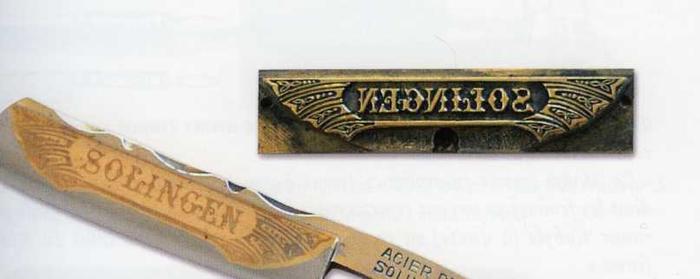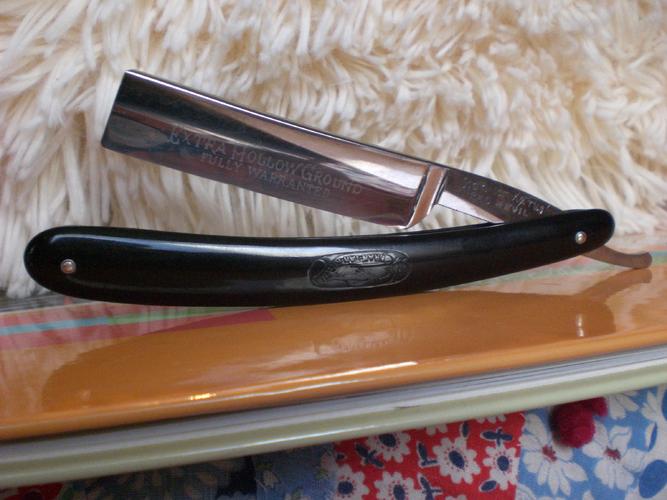Results 21 to 27 of 27
Thread: The hero razor
-
01-23-2013, 10:31 PM #21
-
01-24-2013, 12:46 AM #22

Huh?? Wonder if one razor company was making same razor for different companies?? Mine is a great shaver!!
-
01-25-2013, 02:58 AM #23< Banned User >

- Join Date
- Aug 2012
- Location
- Greenwood, Nova Scotia
- Posts
- 1,144
Thanked: 116
I always wonder about blade etching and who actually provided the patterns for etching. You see the typical 'for barbers use' and 'celebrated hollow ground razor' on a variety of different manufacturers blades especially in the Sheffield area.
I'm hoping Martin has something to chime in with on this one as i've always wondered about blade etchings too.
-
01-25-2013, 02:41 PM #24I love Burls....... and Acrylic



- Join Date
- Mar 2012
- Location
- Baden, Ontario
- Posts
- 5,475
Thanked: 2284
I'm not sure where yours was made, but mines a Johan Engstrom from Sweden. Its od that you see the exact same etching on 2 different blades from different companies. Ya we need Neil, or Manah, or Martin to chime in here!!!
Burls, Girls, and all things that Swirl....
-
01-25-2013, 03:13 PM #25

Must have been a few companies selling etching kits around!
Some etchings make sense and got a clear link to whom made or sold the razor, others are confusing or down right illogical!
-
01-25-2013, 05:20 PM #26Senior Member



- Join Date
- Apr 2008
- Location
- Essex, UK
- Posts
- 3,816
Thanked: 3164
Thanks Andrew!
In the early days etching was done by hand - there are scores of etchers and engravers in the old Sheffield Directories. In fact, most parts of the razor industry was allocated to select groups: horn splitters, horn pressers, mould makers who prepared the ornate cast iron press-moulds for the pressers, engravers, etchers, box makers, etc, etc.
A ground (or resist) of wax, asphalt or soft varnish was set on the blade, the design was made by removing the resist from the parts to be engraved, and the area was covered in acid til 'bitten' to the required depth, then the resist was removed with spirit. It was slow, laborious, painstaking work so only prestige pieces had it applied, or wealthy people would have their blades etched at a later date.
Sometime prior to 1851 a Sheffield man - Thomas Skinner - devised a process that simplified things considerably. Only one thing had to be engraved by hand - a copper plate. This was rolled with oily ink and the excess wiped off, leaving the oil in the engraving. A piece of paper was then put onto the copper plate and pressed into it, transferring the design to the paper. The thin paper was then applied to the blade, the back wetted and after a short time the paper was removed to leave the design on the blade. The blade was covered with a spirit-based varnish which was allowed to dry, then the ink was removed with turpentine (which was not a solvent for the varnish - you needed benzine to remove the varnish. Sometimes a little dam was made around the design and filled with acid, or the rest of the blade had a resist applied and was dipped in acid. With this method you only needed the art of the engraver once - purchase the plate and you can take any amount of prints from it. Razors decorated with this technique were displayed at the 1851 Great Exhibition at Crystal Palace.
With this method the curve of the razor grind was easily taken into account the thin paper 'negative'. However, a more robust and even simpler to manage form was needed and this came about with rubber stamps:

Now only the stamp had to be dipped in resist. Multiple dies allowed for complex designs to be built up.
I suppose someone must have sold plates to make dies and negatives from - it would be a wonder if nobody did! - and no doubt they had a catalogue or pamphlet of types available which makers ordered from - or they engaged the work of a skilled engraver in their own country and got the work done.
Regards,
Neil
-
The Following 3 Users Say Thank You to Neil Miller For This Useful Post:
brooksie967 (01-25-2013), HARRYWALLY (01-26-2013), Lemur (01-25-2013)
-
01-26-2013, 12:11 AM #27I love Burls....... and Acrylic



- Join Date
- Mar 2012
- Location
- Baden, Ontario
- Posts
- 5,475
Thanked: 2284
Well there we go!! Your knowledge is mind blasting sometimes Neil. I should be so lucky to sit down and talk razors with you some day!!! More like me listening.
 Burls, Girls, and all things that Swirl....
Burls, Girls, and all things that Swirl....


 13Likes
13Likes LinkBack URL
LinkBack URL About LinkBacks
About LinkBacks








 Reply With Quote
Reply With Quote